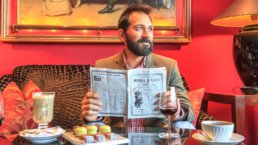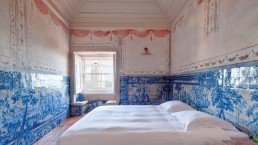Everywhere you go in Portugal you will encounter the national dish of ‘bacalhau‘ (dried and salted codfish) in some guise or form. It is said by some that there are 365 recipes for bacalhau in Portugal, one for each day of the year. Others put that figure at over 1,000. Whichever is the correct number, it can’t be denied that bacalhau has been enjoyed by the Portuguese people for a very long time and continues to be a firm favourite.
The town of Ilhavo, located just 5 kilometres south of Aveiro, breathes the sea air and the salt-filled wind which blows across the Ria de Aveiro lagoons. The people of Ilhavo have long had salt coursing through their veins; whether from dipping their nets in the lowland delta waters, gathering clams from its seashore, or from crossing the Atlantic Ocean in search of the white gold – bacalhau.
Maritime Museum of Ilhavo – The story of the sea
 To fully understand the history of the men who took to the boats over the centuries, risked their lives in the harshest of conditions and left their families behind for months on end, as they skirted the Grand Banks of Canada in pursuit of the humble cod fish, Maritime Museum of Ilhavo is the ideal first port of call.
To fully understand the history of the men who took to the boats over the centuries, risked their lives in the harshest of conditions and left their families behind for months on end, as they skirted the Grand Banks of Canada in pursuit of the humble cod fish, Maritime Museum of Ilhavo is the ideal first port of call.
Housed in a uniquely modern building, in a quiet neighbourhood of Ilhavo, the museum tells the story of the fishermen and of the sea. Originally founded in 1937, the pristine new premises in which the museum is now housed opened its doors in 2001, with the goal of sharing the relationship between the people of the area, the fishermen, the Ria de Aveiro and the agro-maritime heritage which has been a mainstay of the local population for centuries.
Without the doubt, the most impressive display in the museum’s many galleries is the replica of the cod fishing boat, the Faina Maior. Built by local shipwrights, the vessel with its cut-away sections allows visitors to fully explore the workings of a long-line fishing cod ship.
 Through various side exhibitions, you can discover that the boats once they left the port at Ilhavo each April – and from other places up and down the coast – they would gather in Lisbon for a blessing before embarking on the three-week voyage to the Grand Banks. You can learn that how once at sea the men lived their lives, ate, slept, worked and played, and prepared for the long months of fishing ahead.
Through various side exhibitions, you can discover that the boats once they left the port at Ilhavo each April – and from other places up and down the coast – they would gather in Lisbon for a blessing before embarking on the three-week voyage to the Grand Banks. You can learn that how once at sea the men lived their lives, ate, slept, worked and played, and prepared for the long months of fishing ahead.
On the deck of the Faina Maior, you will see the stack of dories; small wooden boats used by solo fishermen to deliver their baited lines to the depths, and which were designed to fit snugly one on top of the other when not in use. You will learn how the men took to these small fragile craft for up to 18 hours a day, laid their lines containing almost 600 baited hooks, and retrieved each fish – some two metres in length – into their boats by hand, only returning to the mother ship once their dory was full with up to 200 Kg of the white gold.
 Back on board the Faina Maior, you will see the bunks, eating and food preparation areas of the 30 men and officers. Although sparse, the quarters of the Captain and his pilot were the laps of luxury in comparison to the men who shared their bunks with their colleagues – because of the lack of space and the need for warmth.
Back on board the Faina Maior, you will see the bunks, eating and food preparation areas of the 30 men and officers. Although sparse, the quarters of the Captain and his pilot were the laps of luxury in comparison to the men who shared their bunks with their colleagues – because of the lack of space and the need for warmth.
Below decks you can find the storage area where the gutted and prepared fish were salted and stored. Along with the bacalhau itself, the by-products from each catch also consisted of cod livers to produce the much sought after Cod Liver Oil, and fish cheeks, tongues and swim bladders which are also highly regarded as Portuguese delicacies.
 For four and a half months, the men would work their dories until either the hold was full to capacity or the onset of winter made it unsafe to fish these treacherous waters. Should there be an accident or any form of illness, the bacalhau fleet had their own hospital boat, such as the Gil Eannes now docked in the port at Viana do Castelo, serving as both a museum and a hostel.
For four and a half months, the men would work their dories until either the hold was full to capacity or the onset of winter made it unsafe to fish these treacherous waters. Should there be an accident or any form of illness, the bacalhau fleet had their own hospital boat, such as the Gil Eannes now docked in the port at Viana do Castelo, serving as both a museum and a hostel.
Once the fishing was complete the flotilla would undertake the three-week journey for home. Through a selection of photographs, you will see the fishermen’s arrival home and the crowds who came out to welcome. You will see the jubilant faces of the men as they received their payment and the equally jubilant faces of wives and children as they welcome their husbands and fathers back on shore.

 But the museum is not all about cod fishing. In another room a selection of boats traditionally used in and around the Ria de Aveiro are displayed: the Bateira Ilhava, the original design for all styles of boats which followed; the Salineiros, boats used for transporting salt; Mercantels, employed for the movement of people and goods; and the beautifully painted Molineiros, whose prows are decorated with the boat-builders symbol and a dedication to God, and whose sterns are usually adorned with a scene of rural or nautical life accompanied by a short slogan with a crude double-entendre meaning. Alongside the boats are examples of the nets, fish traps, shellfish harvesting tools and the spears used by the flounder fishermen and photographs of the objects in use.
But the museum is not all about cod fishing. In another room a selection of boats traditionally used in and around the Ria de Aveiro are displayed: the Bateira Ilhava, the original design for all styles of boats which followed; the Salineiros, boats used for transporting salt; Mercantels, employed for the movement of people and goods; and the beautifully painted Molineiros, whose prows are decorated with the boat-builders symbol and a dedication to God, and whose sterns are usually adorned with a scene of rural or nautical life accompanied by a short slogan with a crude double-entendre meaning. Alongside the boats are examples of the nets, fish traps, shellfish harvesting tools and the spears used by the flounder fishermen and photographs of the objects in use.
Along with an art gallery which houses temporary exhibitions, the Maritime Museum of Ilhavo is also home to one surprising collection. Housed on the museum’s upper floor is a display of almost 5,000 rare seashells collected from around the globe by Pierre Delpeut, a French collector who liked the museum so much he donated his entire cache to the museum in 1965. The collection of shells is complemented by a collection of seaweeds and algae, curated by the museum’s founding father, Américo Teles.
 In yet another gallery there is a temporary exhibition of mapping and navigational technology through the ages, and in yet another, you may view a selection of maritime-themed art and art associated with the Aveiro lagoons in particular. Some of the artworks on display are regarded as masterpieces and unique examples of style and theme from a selection of hugely important artists, such as the eminently respected, João Carlos Celestino Gomes.
In yet another gallery there is a temporary exhibition of mapping and navigational technology through the ages, and in yet another, you may view a selection of maritime-themed art and art associated with the Aveiro lagoons in particular. Some of the artworks on display are regarded as masterpieces and unique examples of style and theme from a selection of hugely important artists, such as the eminently respected, João Carlos Celestino Gomes.
There is enough in Maritime Museum of Ilhavo to keep the curious mind ticking over for hours. From displays of miniature ocean-going vessels, navigational aids and games played by the bacalhau fishermen, to the work of the salt farmers and the ecology of the vast lagoon system. At another nearby site, in Gafanha da Nazare, there is an extension of the museum’s main building, neatly docked in port in the guise of the cod fishing boat the Santo André.

 The final treat for visitors as they prepare to leave the museum is the sight of a giant two-story aquarium. Swimming gently in the 150,000 litres of crystal clear salt water (kept at a constant temperature of 12 degrees centigrade) are 20 large cod fish. Inaugurated in 2013 the aquarium is dedicated to the cod in what appears to be an almost natural environment and truly consolidates all aspects of the museum’s multi-faceted displays.
The final treat for visitors as they prepare to leave the museum is the sight of a giant two-story aquarium. Swimming gently in the 150,000 litres of crystal clear salt water (kept at a constant temperature of 12 degrees centigrade) are 20 large cod fish. Inaugurated in 2013 the aquarium is dedicated to the cod in what appears to be an almost natural environment and truly consolidates all aspects of the museum’s multi-faceted displays.
 If you are lucky enough to visit Aveiro and its surrounding coastal delights, take time to stop by the Maritime Museum of Ilhavo, and perhaps, the experience may be best followed and appreciated at a table with a sea view, accompanied by a fine wine from Centro de Portugal and one of the many bacalhau recipes you’re sure to find on the menu in this beautiful part of the world.
If you are lucky enough to visit Aveiro and its surrounding coastal delights, take time to stop by the Maritime Museum of Ilhavo, and perhaps, the experience may be best followed and appreciated at a table with a sea view, accompanied by a fine wine from Centro de Portugal and one of the many bacalhau recipes you’re sure to find on the menu in this beautiful part of the world.
This Maritime Museum of Ilhavo post is a part of a series of 5 posts I wrote based on my journey to the Aveiro region in July 2016. Please find the links o the other articles bellow:
Disclaimer:
This Maritime Museum of Ilhavo post was written by my inspiring friend Brendan Harding as part of my ongoing collaboration with the Centro de Portugal Tourism Board. All opinions are my own. Photo credits to Emanuele Siracusa.
Brendan Harding
My name is Brendan Harding and I was born and raised in Ireland – that small teddy-bear-shaped island which clings to the edge of the European landmass.
3 Comments
Add comment Cancel reply
This site uses Akismet to reduce spam. Learn how your comment data is processed.







[…] Maritime Museum of Ilhavo […]
[…] Maritime Museum of Ilhavo […]
[…] Maritime Museum of Ilhavo […]